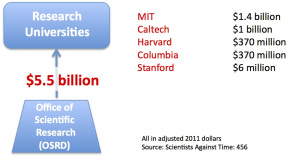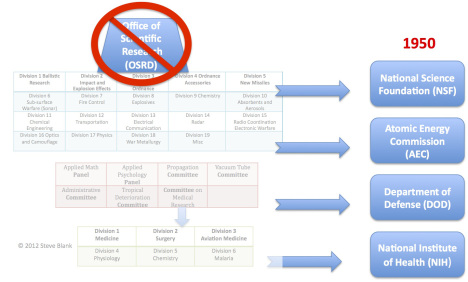The U.S. has spent the last 70 years making massive investments in basic and applied research. Government funding of research started in World War II driven by the needs of the military for weapon systems to defeat Germany and Japan. Post WWII, the responsibility for investing in research split between agencies focused on weapons development and space exploration (being completely customer-driven) and other agencies charted to fund basic and applied research in science and medicine (being driven by peer-review.)
The irony is that while the U.S. government has had a robust national science and technology policy, it lacks a national industrial policy; leaving that to private capital. This approach was successful when U.S. industry was aligned with manufacturing in the U.S., but became much less so in the last decade when the bottom-line drove industries offshore.
In lieu of the U.S. government’s role in setting investment policy, venture capital has set the direction for what new industries attract capital.
This series of blog posts is my attempt to understand how science and technology policy in the U.S. began, where the money goes and how it has affected innovation and entrepreneurship. In future posts I’ll offer some observations how we might rethink U.S. Science and National Industrial Policy as we face the realities of China and global competition.
Office of Scientific Research and Development – Scientists Against Time
As World War II approached, Vannevar Bush, the ex-dean of engineering at MIT, single-handledly reengineered the U.S. governments approach to science and warfare. Bush predicted that World War II would be the first war won or lost on the basis of advanced technology. In a major break from the past, Bush believed that scientists from academia could develop weapons faster and better if scientists were kept out of the military and instead worked in civilian-run weapons labs. There they would be tasked to develop military weapons systems and solve military problems to defeat Germany and Japan. (The weapons were then manufactured in volume by U.S. corporations.)
In 1940, Bush proposed this idea to President Roosevelt who agreed and appointed Bush as head, which was first called the National Defense Research Committee and then in 1941 the Office of Scientific Research and Development (OSRD).
OSRD divided the wartime work into 19 “divisions”, 5 “committees,” and 2 “panels,” each solving a unique part of the military war effort. These efforts spanned an enormous range of tasks – the development of advanced electronics; radar, rockets,sonar, new weapons like proximity fuse, Napalm, the Bazooka and new drugs such aspenicillin and cures for malaria.

The civilian scientists who headed the lab’s divisions, committees and panels were given wide autonomy to determine how to accomplish their tasks and organize their labs. Nearly 10,000 scientists and engineers received draft deferments to work in these labs.
One OSRD project – the Manhattan Project which led to the development of the atomic bomb – was so secret and important that it was spun off as a separate program. The University of California managed research and development of the bomb design lab atLos Alamos while the US Army managed the Los Alamos facilities and the overalladministration of the project. The material to make the bombs – Plutonium and Uranium 235 – were made by civilian contractors at Hanford Washington and Oak Ridge Tennessee.
OSRD was essentially a wartime U.S. Department of Research and Development. Its director, Vannever Bush became in all but name the first presidential science advisor. Think of the OSRD as a combination of all of today’s U.S. national research organizations – the National Science Foundation (NSF), National Institute of Health (NIH), Centers for Disease Control (CDC), Department of Energy (DOE) and a good part of the Department of Defense (DOD) research organizations – all rolled into one uber wartime research organization.
OSRD’s impact on the war effort and the policy for technology was evident by the advanced weapons its labs developed, but its unintended consequence was the impact on American research universities and the U.S. economy that’s still being felt today.
National Funding of University Research
Universities were started with a mission to preserve and disseminate knowledge. By the late 19th century, U.S. universities added scientific and engineering research to their mission. However, prior to World War II corporations not universities did most of the research and development in the United States. Private companies spent 68% of U.S. R&D dollars while the U.S. Government spent 20% and universities and colleges accounted just for 9%, with most of this coming via endowments or foundations.
 Before World War II, the U.S. government provided almost no funding for research inside universities. But with the war, almost overnight, government funding for U.S. universities skyrocketed. From 1941-1945, the OSRD spent $450 million dollars (equivalent to $5.5 billion today) on university research. MIT received $117 million ($1.4 billion in today’s dollars), Caltech $83 million (~$1 billion), Harvard and Columbia ~$30 million ($370 million.) Stanford was near the bottom of the list receiving $500,000 (~$6 million). While this was an enormous sum of money for universities, it’s worth putting in perspective that ~$2 billion was spent on the Manhattan project (equivalent to ~$25 billion today.)
Before World War II, the U.S. government provided almost no funding for research inside universities. But with the war, almost overnight, government funding for U.S. universities skyrocketed. From 1941-1945, the OSRD spent $450 million dollars (equivalent to $5.5 billion today) on university research. MIT received $117 million ($1.4 billion in today’s dollars), Caltech $83 million (~$1 billion), Harvard and Columbia ~$30 million ($370 million.) Stanford was near the bottom of the list receiving $500,000 (~$6 million). While this was an enormous sum of money for universities, it’s worth putting in perspective that ~$2 billion was spent on the Manhattan project (equivalent to ~$25 billion today.)
World War II and OSRD funding permanentlychanged American research universities. By the time the war was over, almost 75% of government research and development dollars would be spent inside Universities. This tidal wave of research funds provided by the war would:
- Establish a permanent role for U.S. government funding of university research, both basic and applied
- Establish the U.S. government – not industry, foundations or internal funds – as the primary source of University research dollars
- Establish a role for government funding for military weapons research inside of U.S. universities (See the blog posts on the Secret History of Silicon Valleyhere, and for a story about one of the University weapons labs here.)
- Make U.S. universities a magnet for researchers from around the world
- Give the U.S. the undisputed lead in a technology and innovation driven economy – until the rise of China.
The U.S. Nationalizes Research
As the war drew to a close, university scientists wanted the money to continue to flow but also wanted to end the government’s control over the content of research. That was the aim of Vannevar Bush’s 1945 report, Science: the Endless Frontier. Bush’s wartime experience convinced him that the U.S. should have a policy for science. His proposal was to create a single federal agency – the National Research Foundation – responsible for funding basic research in all areas, from medicine to weapons systems. He proposed that civilian scientists would run this agency in an equal partnership with government. The agency would have no laboratories of its own, but would instead contract research to university scientists who would be responsible for all basic and applied science research.
But it was not to be. After five years of post-war political infighting (1945-1950), the U.S. split up the functions of the OSRD. The military hated that civilians were in charge of weapons development. In 1946 responsibility for nuclear weapons went to the newAtomic Energy Commission (AEC). In 1947, responsibility for basic weapons systems research went to the Department of Defense (DOD). Medical researchers who had already had a pre-war National Institutes of Health chafed under the OSRD that lumped their medical research with radar and electronics, and lobbied to be once again associated with the NIH. In 1947 the responsibility for all U.S. biomedical and health research went back to the National Institutes of Health (NIH). Each of these independent research organizations would support a mix of basic and applied research as well as product development.
 Finally in 1950, what was left of Vannevar Bush’s original vision – government support of basic science research in U.S. universities – became the charter of the National Science Foundation (NSF). (Basic research is science performed to find general physical and natural laws and to push back the frontiers of fundamental understanding. It’s done without thought of specific applications towards processes or products in mind. Applied research is systematic study to gain knowledge or understanding with specific products in mind.)
Finally in 1950, what was left of Vannevar Bush’s original vision – government support of basic science research in U.S. universities – became the charter of the National Science Foundation (NSF). (Basic research is science performed to find general physical and natural laws and to push back the frontiers of fundamental understanding. It’s done without thought of specific applications towards processes or products in mind. Applied research is systematic study to gain knowledge or understanding with specific products in mind.)
Despite the failure of Bush’s vision of a unified national research organization, government funds for university research would accelerate during the Cold War.
Coming in Part 2 – Cold War science and Cold War universities.
Lessons Learned
- Large scale federal funding for U.S. science research started with the Office of Scientific Research and Development (OSRD) in 1940
- Large scale federal funding for American research universities began with OSRD in 1940
- In exchange for federal science funding, universities became partners in weapons systems research and development















